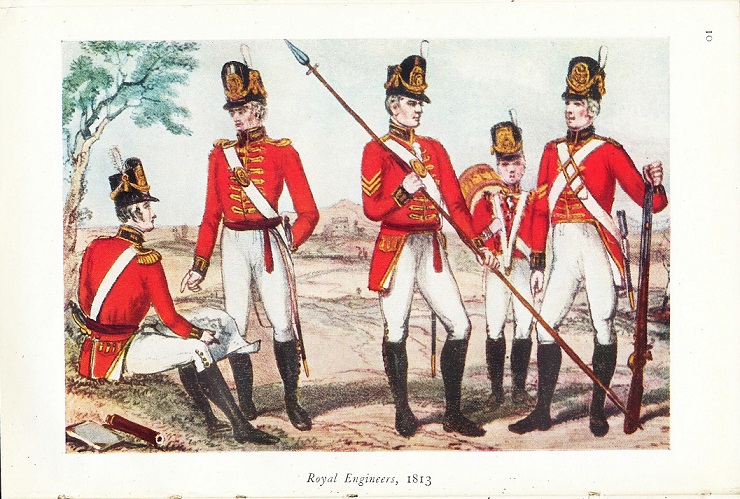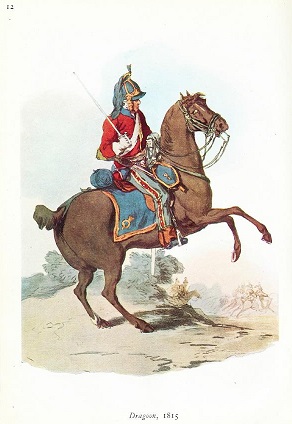 From: British Military Uniforms by James Laver, published by Penguin
From: British Military Uniforms by James Laver, published by Penguin
The Battle of Waterloo was fought on 18 June 1815, in what is now Belgium, between the French and the British and Allied Army. The Seventh Coalition was comprised of forces from the UK, the Netherlands, Hanover, Brunswick, Nassau and Prussia. Gebhard von Blϋcher commanded the Prussian army and a multi-national army was under the command of the Duke of Wellington. The coalition had around 68,000 troops and the French army around 73,000. According to the Duke of Wellington, the battle was ‘the nearest run thing you ever saw in your life’. Blϋcher and Wellington’s victory halted Napoleon’s dream of European domination and he was exiled to St Helena where he died in 1821.
 There is a lot of information online about the Battle of Waterloo, including which regiments were involved and how the battle unfolded. The National Army Museum is commemorating the battle through its ‘Waterloo 200’ project and includes a Waterloo 200 Descendants book which is an e-book featuring stories of the soldiers who fought at the battle. If you think one of your ancestors was at the battle, Ancestry has recently digitised the Muster Books and Pay Lists, series WO 12, held at The National Archives (TNA). These records detail the pay and enlistment records between 1812 and 1817 so include those for the men who fought at the Battle of Waterloo. Findmypast has the Waterloo Medal Roll which details over 36,000 men of all ranks; the Waterloo Roll Call which details of officers and non-commissioned officers and men who fought at Waterloo and were subsequently commissioned and the British Army service records (1760-1915) which has service histories of soldiers on its website as well as other record sets which will help trace your soldier ancestor.
There is a lot of information online about the Battle of Waterloo, including which regiments were involved and how the battle unfolded. The National Army Museum is commemorating the battle through its ‘Waterloo 200’ project and includes a Waterloo 200 Descendants book which is an e-book featuring stories of the soldiers who fought at the battle. If you think one of your ancestors was at the battle, Ancestry has recently digitised the Muster Books and Pay Lists, series WO 12, held at The National Archives (TNA). These records detail the pay and enlistment records between 1812 and 1817 so include those for the men who fought at the Battle of Waterloo. Findmypast has the Waterloo Medal Roll which details over 36,000 men of all ranks; the Waterloo Roll Call which details of officers and non-commissioned officers and men who fought at Waterloo and were subsequently commissioned and the British Army service records (1760-1915) which has service histories of soldiers on its website as well as other record sets which will help trace your soldier ancestor.There was a small newspaper clipping in the book:
‘Infantry Debreeched
Today is not only the anniversary of Waterloo but it is memorable as the day that the British Infantry first put on trousers.
On June 18 1823 the order came from the Commander in Chief the Duke of York: “His Majesty has been pleased to approve of the discontinuance of breeches and leggings and shoes as part of the clothing of the infantry soldiers; and of blue grey cloth trousers and half boots being substituted.”
You would have thought that the infantry would have been pleased to give up their purple breeches, white leggings up to the thigh and purple garters under the knee. But the order caused an uproar far worse than the one that is going to break out on the day they order the Highland Brigade to wear identical tartans. The order of June 18 went on to say that from now on the soldiers would be expected to provide their own waistcoats ‘in order to indemnify the colonels’. The waistcoat money would be stopped from their shilling a day pay.’
Great blog. Seeing the name Blucher transported me back to my Island home of Guernsey where every year at “conker” time we young lads would go to the grounds of what was then Count Bluchers home as the best “conkers in the Island were to be found there.I spent most of my time admiring the house which was and still is lovely. Thanks for bringing back a childhood memory.